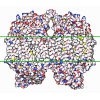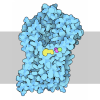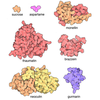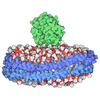[English] 日本語
 Yorodumi
Yorodumi- PDB-6lr4: Molecular basis for inhibition of human gamma-secretase by small ... -
+ Open data
Open data
- Basic information
Basic information
| Entry | Database: PDB / ID: 6lr4 | |||||||||||||||||||||||||||
|---|---|---|---|---|---|---|---|---|---|---|---|---|---|---|---|---|---|---|---|---|---|---|---|---|---|---|---|---|
| Title | Molecular basis for inhibition of human gamma-secretase by small molecule | |||||||||||||||||||||||||||
 Components Components |
| |||||||||||||||||||||||||||
 Keywords Keywords | MEMBRANE PROTEIN / Inhibitor | |||||||||||||||||||||||||||
| Function / homology |  Function and homology information Function and homology informationCajal-Retzius cell differentiation / positive regulation of L-glutamate import across plasma membrane / amyloid precursor protein biosynthetic process / negative regulation of core promoter binding / positive regulation of endopeptidase activity / gamma-secretase complex / short-term synaptic potentiation / aspartic endopeptidase activity, intramembrane cleaving / positive regulation of amyloid precursor protein biosynthetic process / smooth endoplasmic reticulum calcium ion homeostasis ...Cajal-Retzius cell differentiation / positive regulation of L-glutamate import across plasma membrane / amyloid precursor protein biosynthetic process / negative regulation of core promoter binding / positive regulation of endopeptidase activity / gamma-secretase complex / short-term synaptic potentiation / aspartic endopeptidase activity, intramembrane cleaving / positive regulation of amyloid precursor protein biosynthetic process / smooth endoplasmic reticulum calcium ion homeostasis / Noncanonical activation of NOTCH3 / protein catabolic process at postsynapse / TGFBR3 PTM regulation / sequestering of calcium ion / Notch receptor processing / synaptic vesicle targeting / positive regulation of coagulation / central nervous system myelination / negative regulation of axonogenesis / membrane protein intracellular domain proteolysis / skin morphogenesis / choline transport / T cell activation involved in immune response / NOTCH4 Activation and Transmission of Signal to the Nucleus / dorsal/ventral neural tube patterning / ciliary rootlet / neural retina development / regulation of resting membrane potential / L-glutamate import across plasma membrane / Regulated proteolysis of p75NTR / regulation of phosphorylation / myeloid dendritic cell differentiation / metanephros development / endoplasmic reticulum calcium ion homeostasis / brain morphogenesis / locomotion / amyloid precursor protein metabolic process / regulation of synaptic vesicle cycle / regulation of long-term synaptic potentiation / regulation of postsynapse organization / astrocyte activation involved in immune response / embryonic limb morphogenesis / cell fate specification / regulation of canonical Wnt signaling pathway / aggresome / myeloid cell homeostasis / growth factor receptor binding / skeletal system morphogenesis / Hydrolases; Acting on peptide bonds (peptidases); Aspartic endopeptidases / azurophil granule membrane / G protein-coupled dopamine receptor signaling pathway / Golgi cisterna membrane / glutamate receptor signaling pathway / positive regulation of amyloid fibril formation / : / blood vessel development / amyloid-beta formation / mitochondrial transport / amyloid precursor protein catabolic process / heart looping / regulation of neuron projection development / positive regulation of dendritic spine development / adult behavior / positive regulation of receptor recycling / cerebral cortex cell migration / smooth endoplasmic reticulum / nuclear outer membrane / membrane protein ectodomain proteolysis / negative regulation of apoptotic signaling pathway / negative regulation of ubiquitin-dependent protein catabolic process / EPH-ephrin mediated repulsion of cells / autophagosome assembly / endopeptidase activator activity / neuron development / somitogenesis / hematopoietic progenitor cell differentiation / T cell proliferation / regulation of synaptic transmission, glutamatergic / Nuclear signaling by ERBB4 / calcium ion homeostasis / rough endoplasmic reticulum / Degradation of the extracellular matrix / Notch signaling pathway / neuron projection maintenance / astrocyte activation / NOTCH2 Activation and Transmission of Signal to the Nucleus / NRIF signals cell death from the nucleus / cellular response to calcium ion / Activated NOTCH1 Transmits Signal to the Nucleus / cerebellum development / thymus development / positive regulation of glycolytic process / dendritic shaft / epithelial cell proliferation / post-embryonic development / PDZ domain binding / NOTCH3 Activation and Transmission of Signal to the Nucleus / neuromuscular junction / apoptotic signaling pathway / cell-cell adhesion Similarity search - Function | |||||||||||||||||||||||||||
| Biological species |  Homo sapiens (human) Homo sapiens (human) | |||||||||||||||||||||||||||
| Method | ELECTRON MICROSCOPY / single particle reconstruction / cryo EM / Resolution: 3 Å | |||||||||||||||||||||||||||
 Authors Authors | Yang, G. / Zhou, R. / Guo, X. / Lei, J. / Shi, Y. | |||||||||||||||||||||||||||
| Funding support |  China, 1items China, 1items
| |||||||||||||||||||||||||||
 Citation Citation |  Journal: Cell / Year: 2021 Journal: Cell / Year: 2021Title: Structural basis of γ-secretase inhibition and modulation by small molecule drugs. Authors: Guanghui Yang / Rui Zhou / Xuefei Guo / Chuangye Yan / Jianlin Lei / Yigong Shi /  Abstract: Development of γ-secretase inhibitors (GSIs) and modulators (GSMs) represents an attractive therapeutic opportunity for Alzheimer's disease (AD) and cancers. However, how these GSIs and GSMs target ...Development of γ-secretase inhibitors (GSIs) and modulators (GSMs) represents an attractive therapeutic opportunity for Alzheimer's disease (AD) and cancers. However, how these GSIs and GSMs target γ-secretase has remained largely unknown. Here, we report the cryoelectron microscopy (cryo-EM) structures of human γ-secretase bound individually to two GSI clinical candidates, Semagacestat and Avagacestat, a transition state analog GSI L685,458, and a classic GSM E2012, at overall resolutions of 2.6-3.1 Å. Remarkably, each of the GSIs occupies the same general location on presenilin 1 (PS1) that accommodates the β strand from amyloid precursor protein or Notch, interfering with substrate recruitment. L685,458 directly coordinates the two catalytic aspartate residues of PS1. E2012 binds to an allosteric site of γ-secretase on the extracellular side, potentially explaining its modulating activity. Structural analysis reveals a set of shared themes and variations for inhibitor and modulator recognition that will guide development of the next-generation substrate-selective inhibitors. | |||||||||||||||||||||||||||
| History |
|
- Structure visualization
Structure visualization
| Movie |
 Movie viewer Movie viewer |
|---|---|
| Structure viewer | Molecule:  Molmil Molmil Jmol/JSmol Jmol/JSmol |
- Downloads & links
Downloads & links
- Download
Download
| PDBx/mmCIF format |  6lr4.cif.gz 6lr4.cif.gz | 258.6 KB | Display |  PDBx/mmCIF format PDBx/mmCIF format |
|---|---|---|---|---|
| PDB format |  pdb6lr4.ent.gz pdb6lr4.ent.gz | 202 KB | Display |  PDB format PDB format |
| PDBx/mmJSON format |  6lr4.json.gz 6lr4.json.gz | Tree view |  PDBx/mmJSON format PDBx/mmJSON format | |
| Others |  Other downloads Other downloads |
-Validation report
| Summary document |  6lr4_validation.pdf.gz 6lr4_validation.pdf.gz | 1.5 MB | Display |  wwPDB validaton report wwPDB validaton report |
|---|---|---|---|---|
| Full document |  6lr4_full_validation.pdf.gz 6lr4_full_validation.pdf.gz | 1.5 MB | Display | |
| Data in XML |  6lr4_validation.xml.gz 6lr4_validation.xml.gz | 40.7 KB | Display | |
| Data in CIF |  6lr4_validation.cif.gz 6lr4_validation.cif.gz | 62.6 KB | Display | |
| Arichive directory |  https://data.pdbj.org/pub/pdb/validation_reports/lr/6lr4 https://data.pdbj.org/pub/pdb/validation_reports/lr/6lr4 ftp://data.pdbj.org/pub/pdb/validation_reports/lr/6lr4 ftp://data.pdbj.org/pub/pdb/validation_reports/lr/6lr4 | HTTPS FTP |
-Related structure data
| Related structure data |  0957MC  0944C  6lqgC  7c9iC  7d8xC C: citing same article ( M: map data used to model this data |
|---|---|
| Similar structure data |
- Links
Links
- Assembly
Assembly
| Deposited unit | 
|
|---|---|
| 1 |
|
- Components
Components
-Protein , 2 types, 2 molecules AB
| #1: Protein | Mass: 78483.570 Da / Num. of mol.: 1 Source method: isolated from a genetically manipulated source Source: (gene. exp.)  Homo sapiens (human) / Gene: NCSTN, KIAA0253, UNQ1874/PRO4317 / Production host: Homo sapiens (human) / Gene: NCSTN, KIAA0253, UNQ1874/PRO4317 / Production host:  Homo sapiens (human) / References: UniProt: Q92542 Homo sapiens (human) / References: UniProt: Q92542 |
|---|---|
| #2: Protein | Mass: 52713.535 Da / Num. of mol.: 1 Source method: isolated from a genetically manipulated source Source: (gene. exp.)  Homo sapiens (human) / Gene: PSEN1, AD3, PS1, PSNL1 / Production host: Homo sapiens (human) / Gene: PSEN1, AD3, PS1, PSNL1 / Production host:  Homo sapiens (human) Homo sapiens (human)References: UniProt: P49768, Hydrolases; Acting on peptide bonds (peptidases); Aspartic endopeptidases |
-Gamma-secretase subunit ... , 2 types, 2 molecules CD
| #3: Protein | Mass: 29017.943 Da / Num. of mol.: 1 Source method: isolated from a genetically manipulated source Source: (gene. exp.)  Homo sapiens (human) / Gene: APH1A, PSF, CGI-78, UNQ579/PRO1141 / Production host: Homo sapiens (human) / Gene: APH1A, PSF, CGI-78, UNQ579/PRO1141 / Production host:  Homo sapiens (human) / References: UniProt: Q96BI3 Homo sapiens (human) / References: UniProt: Q96BI3 |
|---|---|
| #4: Protein | Mass: 16498.680 Da / Num. of mol.: 1 Source method: isolated from a genetically manipulated source Source: (gene. exp.)  Homo sapiens (human) / Gene: PSENEN, PEN2, MDS033 / Production host: Homo sapiens (human) / Gene: PSENEN, PEN2, MDS033 / Production host:  Homo sapiens (human) / References: UniProt: Q9NZ42 Homo sapiens (human) / References: UniProt: Q9NZ42 |
-Sugars , 3 types, 12 molecules 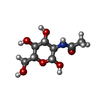
| #5: Polysaccharide | 2-acetamido-2-deoxy-beta-D-glucopyranose-(1-4)-2-acetamido-2-deoxy-beta-D-glucopyranose #6: Polysaccharide | beta-D-mannopyranose-(1-3)-[beta-D-mannopyranose-(1-6)]beta-D-mannopyranose-(1-4)-2-acetamido-2- ...beta-D-mannopyranose-(1-3)-[beta-D-mannopyranose-(1-6)]beta-D-mannopyranose-(1-4)-2-acetamido-2-deoxy-beta-D-glucopyranose-(1-4)-2-acetamido-2-deoxy-beta-D-glucopyranose | Source method: isolated from a genetically manipulated source #7: Sugar | ChemComp-NAG / |
|---|
-Non-polymers , 3 types, 6 molecules 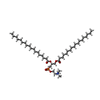

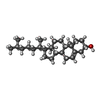


| #8: Chemical | | #9: Chemical | ChemComp-ESF / ( | #10: Chemical | |
|---|
-Details
| Has ligand of interest | Y |
|---|---|
| Has protein modification | Y |
-Experimental details
-Experiment
| Experiment | Method: ELECTRON MICROSCOPY |
|---|---|
| EM experiment | Aggregation state: PARTICLE / 3D reconstruction method: single particle reconstruction |
- Sample preparation
Sample preparation
| Component | Name: human gamma-secretase / Type: COMPLEX / Entity ID: #1-#4 / Source: RECOMBINANT |
|---|---|
| Source (natural) | Organism:  Homo sapiens (human) Homo sapiens (human) |
| Source (recombinant) | Organism:  Homo sapiens (human) Homo sapiens (human) |
| Buffer solution | pH: 7.4 |
| Specimen | Embedding applied: NO / Shadowing applied: NO / Staining applied: NO / Vitrification applied: YES |
| Vitrification | Cryogen name: ETHANE |
- Electron microscopy imaging
Electron microscopy imaging
| Experimental equipment |  Model: Titan Krios / Image courtesy: FEI Company |
|---|---|
| Microscopy | Model: FEI TITAN KRIOS |
| Electron gun | Electron source:  FIELD EMISSION GUN / Accelerating voltage: 300 kV / Illumination mode: FLOOD BEAM FIELD EMISSION GUN / Accelerating voltage: 300 kV / Illumination mode: FLOOD BEAM |
| Electron lens | Mode: BRIGHT FIELD |
| Image recording | Electron dose: 1.5625 e/Å2 / Detector mode: SUPER-RESOLUTION / Film or detector model: GATAN K2 SUMMIT (4k x 4k) |
- Processing
Processing
| Software | Name: PHENIX / Version: 1.12_2829: / Classification: refinement | ||||||||||||||||||||||||
|---|---|---|---|---|---|---|---|---|---|---|---|---|---|---|---|---|---|---|---|---|---|---|---|---|---|
| EM software | Name: PHENIX / Category: model refinement | ||||||||||||||||||||||||
| CTF correction | Type: NONE | ||||||||||||||||||||||||
| 3D reconstruction | Resolution: 3 Å / Resolution method: FSC 0.143 CUT-OFF / Num. of particles: 1044389 / Symmetry type: POINT | ||||||||||||||||||||||||
| Refine LS restraints |
|
 Movie
Movie Controller
Controller




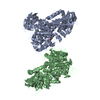

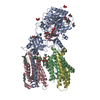
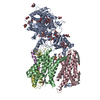
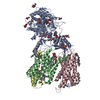
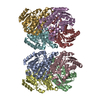

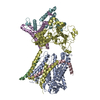
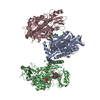
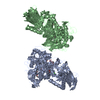
 PDBj
PDBj


